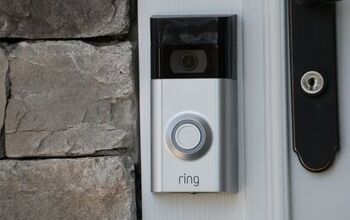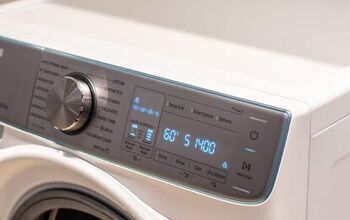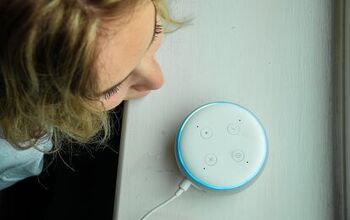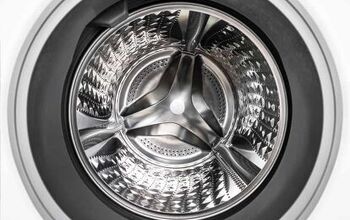Is Your Motion Sensor Light Blinking Red? (We Have a Fix!)

Outdoor floodlights with motion sensors have become a popular part of many home’s nighttime security. The comfort of coming home and having the approach to your door fully illuminated without running lights all the time is important to many people. However, like any mechanical device, motion-sensing lights can have problems. In many cases, the light quits working and the red LED indicator light blinks continuously.
A blinking red indicator light on a motion-sensing light fixture usually means that the light needs resetting. You can reset the light by turning off the power to the light fixture on many residential motion-sensing lights. Some brands of motion-sensor light fixtures may have different methods of resetting the motion-sensing system.
There could be other problems with the motion-sensing light fixture that would cause the LED indicator light to blink. Diagnosing a problem with an exterior motion-sensing light can be frustrating. We have a few tips, tricks, and some steps you can follow to determine and remedy a blinking red indicator light on your motion-sensing light.
Related Content: How To Wire A Motion Sensor To Multiple Lights | Xfinity Home Security vs. ADT
Do You Need to Hire an Electrician?
Get free, zero-commitment quotes from pro contractors near you.

Understanding What’s Happening in your Light
Many things are going on inside your motion-sensing light fixture to make everything work as it should. A basic understanding of what needs to happen for your light to come on consistently and reliably is the first step in diagnosing problems.
The Basic Light Fixture
The basic exterior motion-sensing light fixture has all the common features of any other light fixture. There are wires to connect to the power system in your home. These wires also feed power to the electronics that control the light fixture, including the motion sensor and a photo-sensor.
More expensive models may include things such as:
- A CCTV camera to monitor the area the light illuminates
- A speaker and microphone allowing you to communicate with anyone visible in the camera or around the light fixture
- Solar panels to charge internal backup batteries, so the light fixture continues to operate even if there is a power outage.
- Remote controls allowing you to turn the light on and off independent of the motion sensor and the photoelectric cell. Some of these remote controls allow you to adjust the sensitivity and range of the motion sensors in the light.
You should remember that the more options and accessories attached to the motion-sensing light fixture, the more opportunity for problems. Sometimes simpler is better.
The Motion Sensor – The Sentry of the System
The motion sensor used in most exterior automatic flood light fixtures is an ingenious device. The technology used in modern motion sensors traces its lineage back to World War II and the technological race to protect shipping from submarines.
The motion detectors used in most new motion-sensing light fixtures use ultrasonic sound. The sensor emits an ultrasonic ping. This burst of sound, too high for your human ears to register, bounces back from anything in its path. A small computer tracks these return signals. A moving object, or person, triggers the computer, which turns on the lights.
This simple concept takes some highly sophisticated electronic equipment and a small computer brain. You can see that there can be several problems associated with this technology. When the computer senses a problem, a blinking red indicator light may be the result.
Lights When You Need Lights – The Photoelectric Cell
Almost all new motion-sensing light fixtures include a photoelectric cell. One of the goals of having a motion-sensing light is for the light to come on only when you need it. That is usually after dark.
It doesn’t make much sense to have a motion sensor turn on your light during the day. The photoelectric cell oversees this feature. Sunlight on the photoelectric cell turns the entire sensing system off during daylight, so the light doesn’t come on when it isn’t needed.
There are problems associated with photoelectric cells that can keep your motion-sensing light fixture from working properly. However, a blinking red indicator light is typically not associated with photoelectric cell problems.
Other Accessories and Features
The other features and accessories we mentioned earlier integrate with the motion sensor and the photoelectric cell to operate your light fixture. Understanding and troubleshooting problems with the wide variety of options found on some motion-sensing light fixtures are beyond the scope of this article.
Typically, a problem with one of these accessories or options doesn’t cause the red LED indicator light to blink. A blinking red LED indicator usually means problems with the motion sensor or the computer that controls the light fixture.
Find out how to secure French doors from burglars.
Finding the Problem – Diagnosis and Repair
The best place to start to diagnose a blinking red LED indicator light on your motion-sensing light fixture is with the user manual. There are several reasons for beginning your diagnosis with the user manual.
- Every manufacturer’s design is slightly different – Each manufacturer has its design for both the motion sensing and control systems. While the differences may be subtle, they are important. If possible, consult your user manual for troubleshooting help with your light fixture.
- There may be a code in the blinking LED light – Some motion-sensing light fixtures blink a code to give you a better clue about problems with the light fixture. The user manual will include instructions on interpreting these codes. You may save yourself time and effort by simply counting the number of flashes and looking up the code in the user manual.
- Look for troubleshooting tips in the user manual – Most user manuals prepared by the manufacturer include a troubleshooting guide or table to help you diagnose problems. You should start with this table of known problems and eliminate those before starting anything else.
No User Manual – Check the Obvious Issues
If you don’t have or can’t locate a user manual for your motion-sensing light fixture, there are some generic steps you can take to find the fault. In general, all motion sensor light fixtures share some common characteristics. A few simple steps may easily get your light functioning again.
Step 1: Try a Reset
A rapidly blinking red LED on a motion-sensing light fixture may happen after a power surge or other power-related events. A power surge may have taken the control computer offline. Performing a power down and power up cycle gives the computer a chance to reset and return to normal functions.
If your motion sensing light replaced a standard porch light, it probably still has a wall switch close to the front door. Performing a power cycle in this instance is as easy and flipping the light switch off, waiting a few minutes, and turning the switch back on. Turning the light switch off and on often solves the problem immediately.
Many homeowners have motion-sensing light fixtures around the perimeter of their homes. In general, these light fixtures have a separate electrical circuit providing power. You must turn off the power at the circuit breaker to power cycle these motion-sensing light fixtures. Flip the breaker to the off position, wait a few minutes, and return the circuit breaker to the on position. Check all your motion-sensing fixtures for proper operation.
Step 2: Inspect the Light Fixture
If a reset doesn’t stop the red LED indicator light from blinking, the problem is probably internal to the light fixture. There are several issues to check. Unfortunately, this may involve climbing ladders to reach the light fixture and get close enough to see any possible problems. When you can inspect the light fixture, check for these visible problems.
Before you begin working on the light fixture, turn off the power to the light. If you are testing the light, be careful working around an energized fixture. Working on a fixture with power can be extremely dangerous.
- If the light isn’t working, check the bulbs and replace them if they broke or burned out.
- Check bulbs in the sockets. Light bulbs should be screwed in hand-tight if they are traditional bulbs. LED lights may not have any connectors and may not be changeable.
- Clean the photoelectric cell. The photoelectric cell is usually in a spot that gets full sun. The UV light from direct sunlight can cause plastic lenses to discolor and become almost opaque. If this is the case, you may need to replace the entire light fixture
- Check any seals or gaskets. Rubber seals and gaskets on outdoor fixtures can deteriorate and crack. A bad seal or gasket can allow moisture to get inside the fixture. Moisture, electricity, and electronic parts are a bad combination.
Step 3: Testing and Evaluation
Once you make any repairs to your motion-sensing light fixture, it needs testing. Daylight is a much easier time to work on a light fixture. However, the photoelectric cell will turn off the power to the light. A properly working photoelectric cell can make testing difficult during the daytime.
You can place a small piece of black electrical tape over the photoelectric cell to trick the computer into thinking it is dark. Playing this trick on the computer will allow you to check the functionality and settings on your light fixture without waiting until dark.
Remember when you remove the tape after testing your light fixture to make sure you clean any tape adhesive residue from the photoelectric cell lens. This adhesive can attract and hold dirt and debris if left on the light fixture.
The Last Alternative
If these steps don’t lead you to a successful remedy for the blinking red LED light, the only other option is to replace the entire light fixture. A failed electronic part is not uncommon in these motion-sensing light fixtures. It may simply be time for an upgrade.
Do You Need to Hire an Electrician?
Get free, zero-commitment quotes from pro contractors near you.

The Blinking Red LED – A Symptom to Diagnose
If your motion-sensor light fixture has stopped working and displays a blinking red LED indicator, you can almost bet there is a problem with the electronic systems. We hope that these tips, tricks, and step-by-step instructions help you evaluate and repair your light. Take care when working on anything electrical and good luck with your problem.
Related Articles

Dennis is a retired firefighter with an extensive background in construction, home improvement, and remodeling. He worked in the trades part-time while serving as an active firefighter. On his retirement, he started a remodeling and home repair business, which he ran for several years.
More by Dennis Howard













![10 Best Electric Pressure Washers – [2022 Reviews & Guide]](https://cdn-fastly.upgradedhome.com/media/2023/07/31/9070600/10-best-electric-pressure-washers-2022-reviews-guide.jpg?size=350x220)







![Standard Dining Room Table Dimensions [for 4, 6, 8, 10 and 12 People]](https://cdn-fastly.upgradedhome.com/media/2023/07/31/9074335/standard-dining-room-table-dimensions-for-4-6-8-10-and-12-people.jpg?size=350x220)





